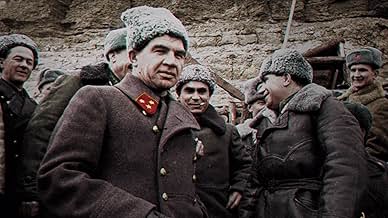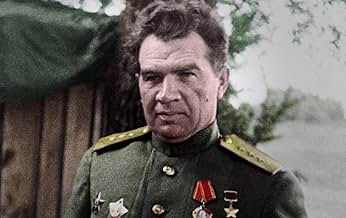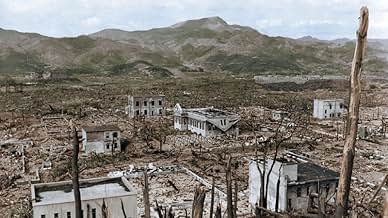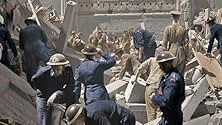Les Grandes Batailles de la 2ᵉ Guerre mondiale
Titre original : Greatest Events of WWII in Colour
- Mini-série télévisée
- 2019
- 50min
Une série d'archives colorées d'événements importants pendant la 2ème Guerre Mondiale.Une série d'archives colorées d'événements importants pendant la 2ème Guerre Mondiale.Une série d'archives colorées d'événements importants pendant la 2ème Guerre Mondiale.
Parcourir les épisodes
Résumé
Reviewers say 'Greatest Events of WWII in Colour' is lauded for its colorized footage and compelling narratives, providing a novel viewpoint on familiar events. However, it is criticized for inaccuracies, exclusion of key events, and a Western-centric bias. Some point out its liberal bias and political undertones, which they believe compromise historical accuracy. Despite these issues, many viewers find the series both informative and enjoyable, though it may not present new revelations for experienced WWII scholars.
Avis à la une
Its so sad listening to so many butthurt complainers nitpicking at everything in this documentary. Honestly you could make a 30 or 40 part documentary series on ww2 and not even scratch the surface of the entire war and do every aspect and every service person justice. Those who complain that their country isn't mentioned... so what. You can't mention every damn country in detail.
I think this documentary series does a splendid job as acting as an introductory series to perhaps children/teenagers learning about ww2 for the first time. (then move on to books) Personally I knew most of the information but I enjoyed hearing it again with some coloured footage. The narrator is really easy to listen to and his commentary is mixed in with some war authors and some vetrans (who are becoming very very few, so these documentations of their experiences are essential)
I think this documentary series does a splendid job as acting as an introductory series to perhaps children/teenagers learning about ww2 for the first time. (then move on to books) Personally I knew most of the information but I enjoyed hearing it again with some coloured footage. The narrator is really easy to listen to and his commentary is mixed in with some war authors and some vetrans (who are becoming very very few, so these documentations of their experiences are essential)
From the beginning I was hooked. The way the show details the events, the strategies, the beautiful footage, interviews, etc was gripping and I binge watched the show over 2 days. It goes into the psychology of the most important people and what led to their decisions. It takes into account the culture of the individual countries at the time and is filled with suspense and twists. It was also very informative, I knew a little bit about WWII from high school classes, but this really helped fill in the gaps in a satisfying way. I feel like I've learned more than in the 2 days of watching this show than I would in a year of study. If you are slightly interested in the events of WWII and want a dramatic narrative of the most important events, this show is for you!
Though I've studied WWII for much of my life, I found this series to be a good, concise description of key events. While it does not go into great depth, it still manages to pack in enough detail with empathetic insights from both Axis and Allied viewpoints. It's an excellent refresher or starting point for key events, which will hopefully engage the viewer to research further.
My only qualm was that the series ends abruptly, with no conclusion/summary. I'd be interested to see a 2nd season into the Cold War, as is hinted at the end of Ep.10.
My only qualm was that the series ends abruptly, with no conclusion/summary. I'd be interested to see a 2nd season into the Cold War, as is hinted at the end of Ep.10.
This series main selling point, according to Netflix is "rare footage from around the world, expertly restored in full color, tells the story as you've never seen it before."
It's true. I've never seen it told with such inaccuracy.
From a purely narrated standpoint, it's not a totally bad documentary. It omits a TON, but makes up for it somewhat by revealing little known details and recollections from people who lived it.
My main beef with this series is that their main selling point is bs. The Dunkirk episode supposedly depicts Ju-87 Stuka dive bombers attempting to pick off English boats and ships in the channel supporting the British Expeditionary Force's evacuation of France. But the footage is not of Stukas, but some other aircraft I had some trouble recognizing. In the Battle of Britain, the Spitfire is mentioned frequently, but the footage is of Hawker Hurricanes, which was already considered obsolete by Spitfire standards by the Summer of 1940. However, the big aerial fight scenes depicting German He-111 medium range bombers and Bf-109E fighters engaging Spitfires over London, are actually re-enactments from the 1969 historical drama "Battle of Britain." The Bf-109Es were not actual Messerschmitts, even, but Spanish HA-1112 Buchons built after the war in the 1950s, that existed in flying condition in greater numbers than actual Messerschmitts, many of which were destroyed by the Allied and Soviet forces as they closed in on Berlin.
Often, substitute footage is used when authentic footage is unavailable or scarce. I get it though. The layman won't be able to tell the difference. What I didn't like so much was that Netflix is peddling this as "rare footage ... expertly restored in full color" -- which leads you to believe all of it, at the very least, is from the era in question, and it's been colorized to give a more accurate depiction of the war.
The final straw for me was a scene during the Pearl Harbor episode, which supposedly depicted Japanese dive bombers attacking Pearl Harbor, with the big red sun emblazoned on their fuselages. But this footage is actually of a US Navy dive bomber called the SBD Dauntless, its stars and bars "photoshopped out" and replaced with the rising sun of Japan. What the hell, Netflix? Top Gun did something similar, by reimagining the USAF F-5 Tiger as the fictious Mig-28, but I doubt any of us went into that theater thinking that this was anything more than RAD on steroids.
If you want to watch a really good documentary on WW2, Ken Burns's "The War" is a great choice. Also, the History Channel ran a terrific series called the "War Room" -- and instead of taking liberties with scarce historical footage, they supplemented their narrative with really neat graphic animations that talked about the tactics and strategies that either lost or won the battles. This Netflix series is a bit of clickbait, and a little bait and switch. There are so many better sources to learn about WW2.
It's true. I've never seen it told with such inaccuracy.
From a purely narrated standpoint, it's not a totally bad documentary. It omits a TON, but makes up for it somewhat by revealing little known details and recollections from people who lived it.
My main beef with this series is that their main selling point is bs. The Dunkirk episode supposedly depicts Ju-87 Stuka dive bombers attempting to pick off English boats and ships in the channel supporting the British Expeditionary Force's evacuation of France. But the footage is not of Stukas, but some other aircraft I had some trouble recognizing. In the Battle of Britain, the Spitfire is mentioned frequently, but the footage is of Hawker Hurricanes, which was already considered obsolete by Spitfire standards by the Summer of 1940. However, the big aerial fight scenes depicting German He-111 medium range bombers and Bf-109E fighters engaging Spitfires over London, are actually re-enactments from the 1969 historical drama "Battle of Britain." The Bf-109Es were not actual Messerschmitts, even, but Spanish HA-1112 Buchons built after the war in the 1950s, that existed in flying condition in greater numbers than actual Messerschmitts, many of which were destroyed by the Allied and Soviet forces as they closed in on Berlin.
Often, substitute footage is used when authentic footage is unavailable or scarce. I get it though. The layman won't be able to tell the difference. What I didn't like so much was that Netflix is peddling this as "rare footage ... expertly restored in full color" -- which leads you to believe all of it, at the very least, is from the era in question, and it's been colorized to give a more accurate depiction of the war.
The final straw for me was a scene during the Pearl Harbor episode, which supposedly depicted Japanese dive bombers attacking Pearl Harbor, with the big red sun emblazoned on their fuselages. But this footage is actually of a US Navy dive bomber called the SBD Dauntless, its stars and bars "photoshopped out" and replaced with the rising sun of Japan. What the hell, Netflix? Top Gun did something similar, by reimagining the USAF F-5 Tiger as the fictious Mig-28, but I doubt any of us went into that theater thinking that this was anything more than RAD on steroids.
If you want to watch a really good documentary on WW2, Ken Burns's "The War" is a great choice. Also, the History Channel ran a terrific series called the "War Room" -- and instead of taking liberties with scarce historical footage, they supplemented their narrative with really neat graphic animations that talked about the tactics and strategies that either lost or won the battles. This Netflix series is a bit of clickbait, and a little bait and switch. There are so many better sources to learn about WW2.
First, in defense of the series against some of the review comments about the source of the video, just because you've seen it in a movie doesn't mean it's not real wartime footage. Older movies, before CGI, did that all the time to save money. For instance, we've all seen that crash of the plane onto the carrier deck in a movie or two, the one where it breaks in half and spins around. But it's real, not shot for a movie.
Second, there's no way to cover everything important that occurred in WWII in 10 hours so obviously many important things will be left out. You can't cover the contributions of every country when so many participated so you pick the major combatants, etc.
My main complaint is in many cases they cover some subjects in such a way as to focus on a more minor topic and leave out the major one. So many examples I can't list them all but here's just one: in the Battle of Britain episode they extensively cover the Spitfire without even a mention of the Hawker Hurricane when in fact there were many more Hurricanes used and Hurricanes were responsible for many more German losses than Spitfires. Yes, the Spitfire was the shiney new plane at the the time. But it's higher complexity meant lower percent availability of the smaller numbers of planes and the Hurricane's quicker turnaround time meant a single Hurricane could fly more sorties in a day. So why not take even 20 seconds to mention the most important British fighter in the Battle, especially the early stages?
Le saviez-vous
- AnecdotesA very descriptive account of human atrocities that should never be forgotten.
Meilleurs choix
Connectez-vous pour évaluer et suivre la liste de favoris afin de recevoir des recommandations personnalisées
- How many seasons does Greatest Events of WWII in Colour have?Alimenté par Alexa
Détails
- Date de sortie
- Pays d’origine
- Langue
- Aussi connu sous le nom de
- Les Grandes Dates de la Seconde Guerre mondiale en couleur
- Sociétés de production
- Voir plus de crédits d'entreprise sur IMDbPro
- Durée
- 50min
- Couleur
Contribuer à cette page
Suggérer une modification ou ajouter du contenu manquant



































